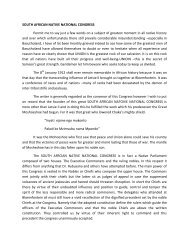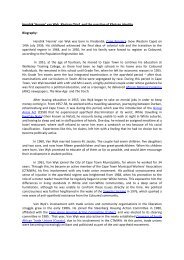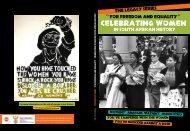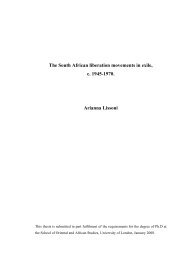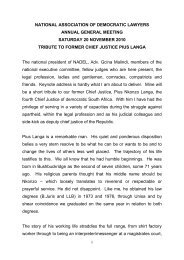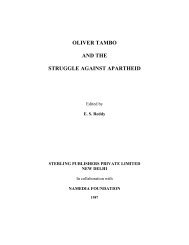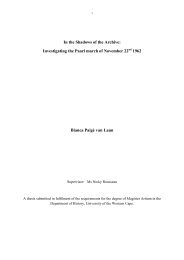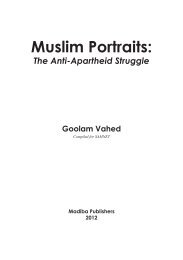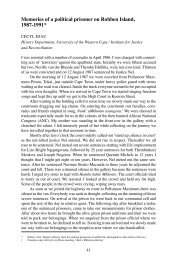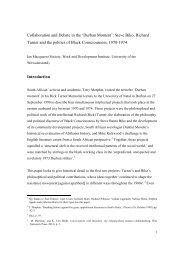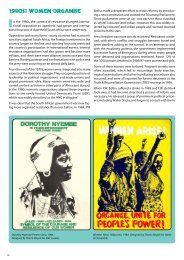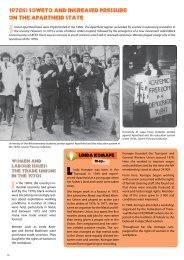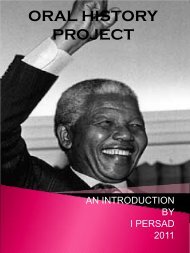Vuyisile Mini - South African History Online
Vuyisile Mini - South African History Online
Vuyisile Mini - South African History Online
You also want an ePaper? Increase the reach of your titles
YUMPU automatically turns print PDFs into web optimized ePapers that Google loves.
<strong>Vuyisile</strong> <strong>Mini</strong><br />
<strong>Vuyisile</strong> <strong>Mini</strong> was born in the Cape in 1920. After completing elementary school he worked as a labourer and<br />
trade union organiser. In 1951 he joined the ANC, and in 1952 was jailed for three months in the Defiance<br />
Campaign. A defendant in the Treason Trial of 1956, he was discharged in 1958. He became Sactu secretary for<br />
the Eastern Cape in 1960.<br />
Charged in 1963 with 17 counts of sabotage and the murder of a police informer, <strong>Vuyisile</strong> <strong>Mini</strong>, together with<br />
Zinakile Mkaba and Wilson Khayingo, was convicted and hanged in Pretoria Central Prison on November 6th,<br />
1964.<br />
<strong>Mini</strong>, of the Eastern Cape High Command of Umkhonto we Sizwe and his two comrades were offered their<br />
lives in exchange for giving information about sabotage activity in their area.<br />
<strong>Mini</strong> wrote: 'I am presently awaiting execution at Pretoria Central Gaol having been sentenced to death at the<br />
beginning of the year. On October 2, 1964, Captain Geldenhuys and two other policemen came to see me.<br />
They asked me if I had been informed that my appeal had been dismissed. I told them I was not interested to<br />
know from them what my advocate said.<br />
They then said there was still a chance for me to be saved as they knew I was the big boss of the movement in<br />
the Eastern Cape. I must just tell them where the detonators and revolvers were, and they would help me. I<br />
refused. They then asked me about Wilton Mkwayi (subsequently sentenced to life imprisonment) and<br />
whether I was prepared to give evidence against Mkwayi, whom they had now arrested. I said no, I was not.<br />
When they asked would I make the Amandla Ngawethu salute when I walked the last few paces to the<br />
gallows, I said yes.'<br />
<strong>Mini</strong>'s unmistakable bass voice, ringing out loud and clear, sent his final message in Xhosa to the world he was<br />
leaving. Charged with emotion, but stubbornly defiant, he spoke of the struggle and of his absolute conviction<br />
of the victory to come. Many of the songs sung by the freedom fighters of today are <strong>Mini</strong>'s compositions.<br />
<strong>Vuyisile</strong> <strong>Mini</strong>'s daughter, Nomkhosi Mary, a founding member of Amandla, the Cultural Ensemble of the ANC,<br />
was among those killed in the <strong>South</strong> <strong>African</strong> commando raid on Maseru, Lesotho on December 20th, 1985.<br />
Issued by:<br />
SACP 65 Years in the Frontline Struggle<br />
Help
Amandla! A Revolution in Four Part Harmony Photo<br />
Through a chronological history of the liberation struggle in <strong>South</strong> Africa, the documentary cites examples of<br />
the way music was used in the fight for freedom. Songs united those being oppressed and gave those fighting<br />
a way to express their plight. The music consoled the incarcerated and created an effective underground form<br />
of communication inside the prisons.<br />
Amandla! - singing down apartheid<br />
Bongani Majola<br />
23 June 2003<br />
The stirring account of the struggle against racial oppression in <strong>South</strong> Africa cannot be told without the role of<br />
music in that struggle, and that's the context and subject matter of Lee Hirsch's documentary film, Amandla!.<br />
For every song, there was pain, for every tune there was joy and heartbreak as <strong>South</strong> <strong>African</strong>s at home and<br />
abroad sought solace and encouragement. Amandla! is an impassioned chronicle of the role of music as a<br />
means of protest and survival through more than 40 years of struggle against apartheid.<br />
Directed by Lee Hirsch, co-produced by Hirsch, Sherry Simpson and Desiree Markgraaff, the documentary took<br />
10 years to make and features well-known political figures, former exiled musicians Hugh Masekela, <strong>Vuyisile</strong><br />
<strong>Mini</strong>, Miriam Makeba, Dolly Rathebe, Sophie Mgcina, Duma ka Ndlovu and Vusi Mahlasela, and former<br />
Umkhonto weSizwe (MK) guerrillas Thandi Modise and Lindiwe Zulu - as well as numerous unsung heroes.<br />
Subtitled "A Revolution in Four-Part Harmony", Amandla! It is a poignant portrayal of the triumph of spirit,<br />
through song, against one of the world's most repressive state apparatuses. "The apartheid government took<br />
everything away from people, but it couldn’t stop them from singing", says Hirsch.<br />
In song lay the resilient spirit of an oppressed people. Also in song could be found that rare ability of <strong>South</strong><br />
Africa's people to find humour and creativity in impossible conditions, in abject poverty - and in battle.<br />
When the first victims of apartheid brutality died protesting against the pass laws in the 1960s, they were<br />
singing. When innocent students were fired on by police with live ammunition during their protest against the<br />
use of Afrikaans in black schools in 1976, they were in song.<br />
As Masekela amiably puts it: "We will go down in history as an army that spent a lot of time singing, rather<br />
than fighting".<br />
Legend has it, according to Masekela, that before the first shot was fired in the Anglo-Zulu War of 1879, the<br />
British commanders ordered their regiments to let the approaching Zulu impis finish the song they were<br />
singing - before war broke out in earnest.<br />
Amandla! is a typically <strong>South</strong> <strong>African</strong> story that begins with the exhumation of <strong>Vuyisile</strong> <strong>Mini</strong>'s skull and bones,<br />
to be reburied in his home in the Cape. Credited with writing the ominous song "Bhasobha iNdoda eMnyama<br />
Verwoerd" (Beware the black man, Verwoerd), which became a rallying cry for many liberation army soldiers,<br />
political activist and songwriter <strong>Mini</strong> was hanged and given a pauper's burial by the apartheid government.<br />
The documentary also captures the archetypal <strong>South</strong> <strong>African</strong> war dance, the toyi-toyi. While a marvel to<br />
watch, as throngs of "comrades" charge forward chanting slogans, the toyi-toyi could strike fear even in the<br />
most menacingly armed forces of the land.
Former riot police commanders, interviewed in the film, admit as much: "I can tell you that most of the riot<br />
police and soldiers who had to contain those illegal marches were shit-scared of the chanting blacks<br />
confronting them. But they had to stand their guard. Here was an unarmed mob instilling fear just by their<br />
toyi-toyi!"<br />
Over and above the toyi-toyi, there are heart-rending moments in the documentary, accompanied by<br />
intensely moving songs such as Vusi Mahlasela's ballads, Masekela’s "Stimela" and the works of "People's<br />
Poet" Mzwakhe Mbuli.<br />
Amandla! also features the music of <strong>Vuyisile</strong> <strong>Mini</strong>, Mbongeni Ngema, Hugh Masekela, Miriam Makeba, Dolly<br />
Rathebe, Abdullah Ibrahim, Sibongile Khumalo and Sophie Mgcina. Mahlasela, Masekela, Makeba, Rathebe,<br />
Ibrahim, Khumalo and Mgcina are all interviewed in the documentary.<br />
"The film has been an emotional journey for us as filmmakers, and we hope it will be for the audience that<br />
come to watch. It is the history of a voice that gave courage, hope and comfort, and will be an important<br />
historical reference for future generations", says Markgraaff.<br />
Winner of the 2002 Sundance Festival Documentary Audience and Freedom of Expression Awards, the film's<br />
only weakness is by omission. Time and the constraints of making a film could not possibly do justice to half a<br />
century of song in <strong>South</strong> Africa. Equally, the film could have interviewed a more varied range of musicians,<br />
activists and ordinary people.<br />
However, the power and the urgency of freedom music lives on in the documentary. An inspirational call to<br />
arms, "Amandla!" (power) - followed by the retort "Awethu!" (ours) - means power to the people, and the<br />
documentary is testimony to that powerful triumph of spirit.<br />
Amandla! runs for 102 minutes and is currently showing at selected cinemas across the country.<br />
<br />
<br />
Click here to watch the Dave Matthews interview on Amandla!<br />
The soundtrack to Amandla! which includes pre-recorded masterpieces from legendary <strong>South</strong> <strong>African</strong><br />
musicians, new voices from <strong>South</strong> Africa, as well as amazing never-before-heard field recordings and<br />
performances recorded exclusively for the movie. One dollar from every record sold will be donated to<br />
the Vusi Mahlasela Foundation, a music resource centre for young people in Pretoria. More info,<br />
orders<br />
May 1, 2002<br />
sojo.net<br />
Reviews<br />
Singing Down the Walls<br />
by Robin Fillmore Chapin<br />
Film Review: Lee Hirsch, Amandla! A Revolution in Four-Part Harmony (HBO: 2002).<br />
The film opens with a faint sound, a vibration that says something's coming, and so you listen very closely.<br />
Then there are voices—many—singing the full and glorious harmonies of Africa. It's an overwhelming gospel<br />
of possibility sung by those who had nothing but hope and their voices with which to sing. Such is Amandla! A<br />
Revolution in Four-Part Harmony, a documentary produced and directed by Lee Hirsch on the critical role<br />
music played in the struggle against apartheid in <strong>South</strong> Africa.
Amandla!, which means "power" in Swahili, is an HBO-financed project that won the Documentary Audience<br />
Award at the Sundance Film Festival in January. It will air on HBO, although programmers haven't yet set a<br />
date. Part living history lesson, part archival search, Hirsch interviews activists, poets, and singers for their<br />
stories of how they lived under the brutally repressive system of forced separation in <strong>South</strong> Africa. Activists<br />
explain how the songs and chants gave voice to blacks as they narrated the stories of the forced relocations<br />
from their homes in the city into shantytowns. The songs said to the minority whites: "Here are the black<br />
people." By also including archival films, Hirsch puts us in the front row of the chorus, where historic<br />
gatherings of protesters sang with every part of their bodies—their feet dancing, their hands raised in fists of<br />
prayer, and their heads bobbing to a rhythm of release. The struggle against apartheid consumed one's life<br />
and soul.<br />
THE DOCUMENTARY'S central character is <strong>Vuyisile</strong> <strong>Mini</strong>, who we first see as his body is being exhumed from a<br />
potter's field. Executed by hanging in 1963 in a Pretoria jail, <strong>Mini</strong> was a trade labor organizer whose stirring<br />
bass voice and impassioned lyrics aroused blacks to remain defiant in the face of apartheid and committed to<br />
the ideal that victory over oppression was inevitable. <strong>Mini</strong>'s songs were neither dirges nor fight songs but<br />
soulful chants with melodies of promise. Not understanding the language, white teachers unknowingly led<br />
their black students in singing <strong>Mini</strong>'s words—among them "White man, we're gonna hurt you."<br />
In the film, <strong>Mini</strong>'s heirs are brought together to re-inter his body and to offer this hero of the revolution a<br />
proper burial. As dignity is restored to <strong>Mini</strong>'s body, dignity is restored to the millions of blacks in <strong>South</strong> Africa.<br />
Like the walls of Jericho, the walls of apartheid were blown down with song.<br />
The film does nothing to capture the current state of crisis and disease in <strong>South</strong> Africa, but, in fairness, that<br />
isn't what director Hirsch intended. He leaves his audience with the belief that the world is a better place<br />
without the horrors of apartheid, and for that, we thank him. Hirsch has reconstructed a world so vivid in its<br />
colors and so compelling in its symphony that we can see the faces, visit the places, and hear the tales of those<br />
who committed themselves to spreading the gospel of justice. And we're also left singing <strong>Vuyisile</strong> <strong>Mini</strong>'s<br />
words: "Mayihambe le vangeli; Mayigqib ilizwe lonke," or "Let this gospel spread and be known through the<br />
world."<br />
Robin Fillmore Chapin is director of internship, education, and hospitality at Sojourners. See www.hbo.com to<br />
check screening dates.<br />
March 31, 2002<br />
Sunday Times - <strong>South</strong> Africa<br />
The soundtrack to SA's story<br />
The Wild, Wild West<br />
How is the story of the past 50 years to be told? Whose memory is true enough to tell it all, to encapsulate it<br />
just so, and give it to generations to come?<br />
Our country bristles with stories waiting to be told. There are the young women - girls, really, children - who<br />
left <strong>South</strong> Africa in fear to join a liberation movement they probably misunderstood and knew very little
about. Who will tell their stories of love and fear? Of longing and despair? Of joy and hope?<br />
Then there are the young men, the ones who were afraid and did not want to patrol townships in the dead of<br />
night, the ones who were conscripted and spent two years of their lives being ordered about and sent to fight<br />
in Angola. How do we tell future generations about their fear as they faced an unknown and angry enemy, as<br />
they died a lonely death in places whose names they could not even pronounce and whose people they were<br />
indoctrinated to know only as terrorists? How do we tell our children that in our time children were given guns<br />
to go and kill other children?<br />
Then there are the stories of those who spent years in prison to end apartheid. Then they came out, and<br />
watched in confusion as their people faced rising unemployment, were retrenched from jobs and lived in<br />
squalor and indignity in squatter camps. Who is to tell of their anger and despair as it becomes clear that even<br />
under a beautiful democracy such as ours, some will die of hunger and disease?<br />
I first heard the story of <strong>Vuyisile</strong> <strong>Mini</strong> from my younger brother. "<strong>Vuyisile</strong> <strong>Mini</strong>," he said, "went to the gallows<br />
singing. He was the first Umkhonto weSizwe soldier to be executed by the apartheid government." When <strong>Mini</strong><br />
was sent to prison his youngest daughter was two years old. After hanging him, the government gave him a<br />
pauper's funeral and refused to tell his family where or how he was buried.<br />
<strong>Mini</strong> was no ordinary man. He was a poet, a fantastic singer, a composer of songs. He was a freedom fighter.<br />
<strong>Mini</strong> knew something about the telling of stories and the preservation of memory. He composed songs that<br />
ensured people never forgot the injustices around them. Many of us have heard Miriam Makeba sing that<br />
beautiful song Nantsi Indoda eMnyama Verwoerd! (Here comes the black man, Verwoerd!). It was a <strong>Mini</strong> song<br />
- simple, combative, haunting. It has been sung again and again in the capitals of the world and in this country,<br />
and it embodies the spirit of freedom that beats in every caged bird and human being.<br />
Lee Hirsch has tried to tell the story of the past 50 years. In his beautiful and haunting film Amandla! A<br />
Revolution in Four-Part Harmony, Hirsch tells a simple and yet complex story: almost every facet of <strong>South</strong><br />
Africa's struggle was characterised by songs. Those who opposed apartheid always sang when they protested.<br />
The women who marched on the Union Buildings in the 1950s sang; the people of Sharpeville, who were<br />
murdered for burning their passes sang; the children of 1976 sang, the men and women who went into<br />
military camps in Angola and Zambia sang, those who marched on Trafalgar Square sang, and the men and<br />
women who went on the defiance campaign of the late 1980s sang.<br />
They sang as they were arrested, sang as they were shot at, sang as they were chased by the police. They sang,<br />
like <strong>Mini</strong>, as they were murdered. They sang different songs, songs which suited the moment - the angry toyitoyi<br />
songs, the dirges, the laments, the prayers, the chants of joy and of pain.<br />
In his film, Hirsch tells the story of the music. He tells of <strong>Mini</strong>'s music, of the Dolly Rathebes and Miriam<br />
Makebas, of Nkosi Sikelel' iAfrika. With every song there is a story: of pain, of joy, of heartbreak.
"This story will remind you why you always want to go home if you are outside of <strong>South</strong> Africa," a friend told<br />
me before I went to see it in London. He was right. Amandla! is a triumph, and I hope as many of us as possible<br />
see it when it opens in <strong>South</strong> Africa, fittingly, on April 27.<br />
-By Justice Malala



